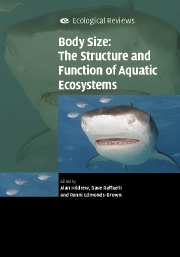Book contents
- Frontmatter
- Contents
- List of contributors
- Preface
- 1 The metabolic theory of ecology and the role of body size in marine and freshwater ecosystems
- 2 Body size and suspension feeding
- 3 Life histories and body size
- 4 Relationship between biomass turnover and body size for stream communities
- 5 Body size in streams: macroinvertebrate community size composition along natural and human-induced environmental gradients
- 6 Body size and predatory interactions in freshwaters: scaling from individuals to communities
- 7 Body size and trophic cascades in lakes
- 8 Body size and scale invariance: multifractals in invertebrate communities
- 9 Body size and biogeography
- 10 By wind, wings or water: body size, dispersal and range size in aquatic invertebrates
- 11 Body size and diversity in marine systems
- 12 Interplay between individual growth and population feedbacks shapes body-size distributions
- 13 The consequences of body size in model microbial ecosystems
- 14 Body size, exploitation and conservation of marine organisms
- 15 How body size mediates the role of animals in nutrient cycling in aquatic ecosystems
- 16 Body sizes in food chains of animal predators and parasites
- 17 Body size in aquatic ecology: important, but not the whole story
- Index
- References
5 - Body size in streams: macroinvertebrate community size composition along natural and human-induced environmental gradients
Published online by Cambridge University Press: 02 December 2009
- Frontmatter
- Contents
- List of contributors
- Preface
- 1 The metabolic theory of ecology and the role of body size in marine and freshwater ecosystems
- 2 Body size and suspension feeding
- 3 Life histories and body size
- 4 Relationship between biomass turnover and body size for stream communities
- 5 Body size in streams: macroinvertebrate community size composition along natural and human-induced environmental gradients
- 6 Body size and predatory interactions in freshwaters: scaling from individuals to communities
- 7 Body size and trophic cascades in lakes
- 8 Body size and scale invariance: multifractals in invertebrate communities
- 9 Body size and biogeography
- 10 By wind, wings or water: body size, dispersal and range size in aquatic invertebrates
- 11 Body size and diversity in marine systems
- 12 Interplay between individual growth and population feedbacks shapes body-size distributions
- 13 The consequences of body size in model microbial ecosystems
- 14 Body size, exploitation and conservation of marine organisms
- 15 How body size mediates the role of animals in nutrient cycling in aquatic ecosystems
- 16 Body sizes in food chains of animal predators and parasites
- 17 Body size in aquatic ecology: important, but not the whole story
- Index
- References
Summary
Introduction
Communities contain a diversity of species and a spectrum of life forms. A consequence of evolutionary processes is that lists of species from different communities tell us almost nothing about how similar they are ecologically. On the other hand, by quantifying the life-history traits represented, we can discern similarities and differences among communities and gain an understanding of the functional relationships between traits and habitats. In response to Southwood's (1977) contention that habitat provides the templet upon which evolution forges characteristic life-history strategies, we are interested in the extent to which life-history traits of macroinvertebrates can be directly mapped onto stream habitat axes. More recently, stream researchers have used the metaphor of environmental filters (Poff, 1997) that can eliminate certain traits and produce similar trait compositions in similar habitats (Statzner, Dolédec & Hugueny, 2004). Trait-specific selective forces along environmental gradients may act over evolutionary time, as Southwood (1977) contended, or over an ecological time scale, selecting for successful strategists from the potential pool of colonists.
The earliest categorization of species traits in stream ecology related to trophic role. Cummins (1974) identified grazer-scrapers, fine particle collectors (gatherers or filterers), large particle shredders and predators. Stream ecologists now use this trophic categorization to focus on the similarities and differences of communities in different parts of the world (e.g. Winterbourn, Rounick & Cowie, 1981; Thompson & Townsend, 2000; Fenoglio, Bo & Cucco, 2004), in different parts of the river continuum (e.g. Vannote et al. 1980; Grubaugh, Wallace & Houston, 1996) and in different kinds of terrestrial setting (e.g. Thompson & Townsend, 2000; Woodward & Hildrew, 2002).
- Type
- Chapter
- Information
- Publisher: Cambridge University PressPrint publication year: 2007
References
- 15
- Cited by



